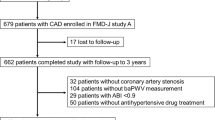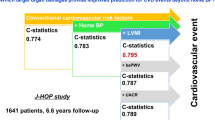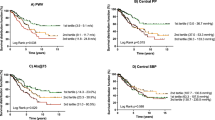Abstract
In treated hypertensive patients, there is a substantial residual cardiovascular (CV) risk that cannot be assessed by the available prediction models. This risk can be associated with subclinical organ damage, such as increased left ventricular mass (LVM) and arterial stiffness. However, it remains unknown which of these two CV markers better predicts coronary artery disease (CAD). A prospective cohort study was used to answer the above question. The study sample consisted of 1033 patients with hypertension (mean age 55.6 years, 538 males) free of CAD at baseline, who were followed for a mean period of 6 years. At baseline, all subjects underwent a complete echocardiographic study and pulse wave velocity (PWV) measurement. Hypertensive individuals who developed CAD (2.8%) compared to those without CAD at follow-up, had a higher baseline LVM index (by 16.7 g/m2, p < 0.001), higher prevalence of left ventricular hypertrophy (LVH) (21% greater, p = 0.027) and greater prevalence of high PWV levels at baseline (21% greater, p = 0.019). Multivariate Cox regression analysis revealed that baseline age >65 years (HR = 2.067, p = 0.001), male gender (HR = 3.664, p = 0.001), baseline chronic kidney disease (HR = 2.020, p = 0.026), baseline diabetes mellitus (HR = 1.952, p = 0.015) and baseline LVH (HR = 2.124 p = 0.001) turned out to be independent predictors of CAD, whereas high PWV levels were not. LVH proved to be an independent prognosticator of CAD in contrast to arterial stiffness that was not related to CAD after accounting for established confounders. Therefore, LVM can reliably help physicians to identify high-risk hypertensives in whom an intensified therapeutic management is warranted.
This is a preview of subscription content, access via your institution
Access options
Subscribe to this journal
Receive 12 digital issues and online access to articles
$119.00 per year
only $9.92 per issue
Buy this article
- Purchase on Springer Link
- Instant access to full article PDF
Prices may be subject to local taxes which are calculated during checkout

Similar content being viewed by others
References
Piepoli MF, Hoes AW, Agewall S, Albus C, Brotons C, Catapano AL, et al. ESC Scientific Document Group. 2016 European Guidelines on Cardiovascular Disease Prevention in Clinical Practice: The Sixth Joint Task Force of the European Society of Cardiology and Other Societies on Cardiovascular Disease Prevention in Clinical Practice (constituted by representatives of 10 societies and by invited experts) Developed with the special contribution of the European Association for Cardiovascular Prevention & Rehabilitation (EACPR). Eur Heart J. 2016;37:2315–81.
Volpe M, Battistoni A, Tocci G, Rosei EA, Catapano AL, Coppo R, et al. Cardiovascular risk assessment beyond Systemic Coronary Risk Estimation: a role for organ damage markers. J Hypertens. 2012;30:1056–64.
Sehestedt T, Jeppesen J, Hansen TW, Wachtell K, Ibsen H, Torp-Pedersen C, et al. Risk prediction is improved by adding markers of subclinical organ damage to SCORE. Eur Heart J. 2010;31:883–91.
Ruilope LM, Schmieder RE. Left ventricular hypertrophy and clinical outcomes in hypertensive patients. Am J Hypertens. 2008;21:500–8.
Cavalcante JL, Lima JA, Redheuil A, Al-Mallah MH. Aortic stiffness: current understanding and future directions. J Am Coll Cardiol. 2011;57:1511–22.
Williams B, Mancia G, Spiering W, Agabiti Rosei E, Azizi M, Burnier M, et al. 2018 Practice Guidelines for the management of arterial hypertension of the European Society of Hypertension and the European Society of Cardiology: ESH/ESC Task Force for the Management of Arterial Hypertension. J Hypertens. 2018;36:2284–309.
Lang RM, Bierig M, Devereux RB, Flachskampf FA, Foster E, Pellikka PA, et al. American Society of Echocardiography’s Guidelines and Standards Committee; European Association of Echocardiography. Recommendations for chamber quantification: a report from the American Society of Echocardiography’s Guidelines and Standards Committee and the Chamber Quantification Writing Group, developed in conjunction with the European Association of Echocardiography, a branch of the European Society of Cardiology. J Am Soc Echocardiogr. 2005;18:1440–63.
Tsioufis C, Dimitriadis K, Selima M, Thomopoulos C, Mihas C, Skiadas I, et al. Low-grade inflammation and hypoadiponectinaemia have an additive detrimental effect on aortic stiffness in essential hypertensive patients. Eur Heart J. 2007;28:1162–9.
National Kidney Foundation. K/DOQI clinical practice guidelines for chronic kidney disease: evaluation, classification, and stratification. Am J Kidney Dis. 2002;39:S1–S266.
Andrikou I, Tsioufis C, Dimitriadis K, Konstantinidis D, Kasiakogias A, Kouremeti M, et al. Uric acid as an independent predictor of coronary artery disease in essential hypertension: Data from an 8-year-follow-up study. Clin Exp Pharm Physiol. 2018;45:866–9.
Zalawadiya SK, Gunasekaran PC, Bavishi CP, Veeranna V, Panaich S, Afonso L. Left ventricular hypertrophy and risk reclassification for coronary events in multi-ethnic adults. Eur J Prev Cardiol. 2015;22:673–9.
Andrikou E, Tsioufis C, Thomopoulos C, Andrikou I, Kasiakogias A, Leontsinis I, et al. Left ventricular mass index as a predictor of new-onset microalbuminuria in hypertensive subjects: a prospective study. Am J Hypertens. 2012;25:1195–201.
Gerdts E, Cramariuc D, de Simone G, Wachtell K, Dahlöf B, Devereux RB. Impact of left ventricular geometry on prognosis in hypertensive patients with left ventricular hypertrophy (the LIFE study). Eur J Echocardiogr. 2008;9:809–15.
Schillaci G, Verdecchia P, Porcellati C, Cuccurullo O, Cosco C, Perticone F. Continuous relation between left ventricular mass and cardiovascular risk in essential hypertension. Hypertension. 2000;35:580–6.
Ben-Shlomo Y, Spears M, Boustred C, May M, Anderson SG, Benjamin EJ, et al. Aortic pulse wave velocity improves cardiovascular event prediction: an individual participant meta-analysis of prospective observational data from 17,635 subjects. J Am Coll Cardiol. 2014;63:636–46.
Vlachopoulos C, Aznaouridis K, Stefanadis C. Prediction of cardiovascular events and all-cause mortality with arterial stiffness: a systematic review and meta-analysis. J Am Coll Cardiol. 2010;55:1318–27.
Kim HL, Kim SH. Pulse wave velocity in atherosclerosis. Front Cardiovasc Med. 2019;6:41.
Verdecchia P, Angeli F, Gattobigio R, Sardone M, Pede S, Reboldi GP. Regression of left ventricular hypertrophy and prevention of stroke in hypertensive subjects. Am J Hypertens. 2006;19:493–9.
Okin PM, Devereux RB, Jern S, Kjeldsen SE, Julius S, Nieminen MS. LIFE Study Investigators et al. Regression of electrocardiographic left ventricular hypertrophy during antihypertensive treatment and the prediction of major cardiovascular events. JAMA. 2004;292:2343–9.
Frohlich ED. State of the art lecture. Risk mechanisms in hypertensive heart disease. Hypertension. 1999;34:782–9.
Shlomai G, Grassi G, Grossman E, Mancia G. Assessment of target organ damage in the evaluation and follow-up of hypertensive patients: where do we stand? J Clin Hypertens. 2013;15:742–7.
Smith SC Jr. Current and future directions of cardiovascular risk prediction. Am J Cardiol. 2006;97:28A–32A.
Author information
Authors and Affiliations
Corresponding author
Ethics declarations
Competing interests
The authors declare no competing interests.
Additional information
Publisher’s note Springer Nature remains neutral with regard to jurisdictional claims in published maps and institutional affiliations.
Rights and permissions
About this article
Cite this article
Andrikou, I., Dimitriadis, K., Konstantinidis, D. et al. Left ventricular mass versus pulse wave velocity as predictors of coronary artery disease in hypertensive patients: data from a 6-year-follow-up study. J Hum Hypertens 36, 617–621 (2022). https://doi.org/10.1038/s41371-021-00560-1
Received:
Revised:
Accepted:
Published:
Issue Date:
DOI: https://doi.org/10.1038/s41371-021-00560-1



